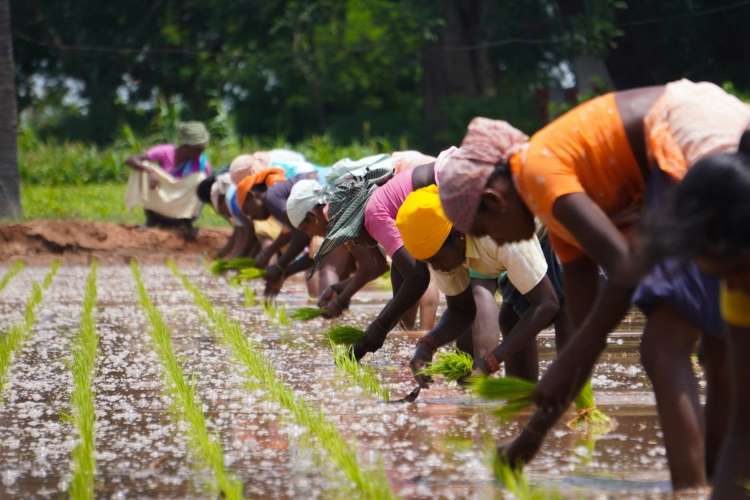
With several North Indian states facing a dry spell this monsoon season, sowing patterns of paddy crops has been severely affected and this will cause a decline in paddy cultivation. Apart from the crop shortage, the rainfall deficiency is likely to impact livestock and farmers’ livelihoods. The states that have faced a decline in rainfall include Bihar, Uttar Pradesh, Jharkhand, and West Bengal which collectively account for a third of India’s rice production.
Economists fear a double whammy for the government which will be forced to either dip into rice buffer stock or allow a price rise. Either way, it will face a huge crisis if other states fail to compensate the shortfall in rice cultivation.
About a fifth of the estimated paddy production in UP and Bihar at around 15.5 million metric tonnes is likely to be affected by rainfall deficiency. This translates into a net impact or loss of close to 3 million metric tonnes of paddy from the two states alone. India produces around 105 million tonnes of paddy annually.
READ I Shift to renewables will cut cost of farming, strengthen food security
Farming woes beyond paddy
In India, crops are sown in two seasons called kharif and rabi. Kharif crops are sown before the beginning of the monsoon season around May-end to early June and these crops are harvested after the monsoon ends in October. Rice, maize, pulses such as urad, moong dal and millets are among the major Kharif crops grown in the country.
Uttar Pradesh and Bihar also produce other crops which will also bear the brunt of erratic rainfall pattern. These two states also have unique challenges to face. With a drought impending, farmers in these states may be forced to shift to other crops. Uttar Pradesh, for instance, troubled with sowing of its kharif crop, is likely to see a switch to pulses.
However, deficient rainfall is not the only cause of concern for farmers. In fact, incessant rainfall in Tamil Nadu has also hit cotton and maize cultivation. More than 1,000 acres of crops have been destroyed in Salem, Erode and Tiruchirappalli that are key cotton growing districts in the state. After paddy, maize is the second most adversely impacted Kharif crop this year. India is also the world’s second-largest producer of rice, a substantial amount of which is grown under rain-fed conditions during the Kharif.
The impact on any crop also has a domino effect on industries which are dependent on crops for raw material. This includes industries like chicken and meat.
Why rainfall is central to Indian agriculture
While India is still an agriculture first country, it has been a big puzzle for policy makers and analysts as to why the country is unable to move beyond its dependency on rainfall for cultivation. This becomes an especially pertinent question considering increasing erratic pattern in rainfalls and other climatic conditions due to global warming. Any deficiency in rainfall and the resultant changes substantially affect farmers’ livelihoods and have considerable social impact.
READ | UGC woos foreign universities with autonomy promise; chokes the best at home
The human cost
In states including Bihar, UP and Jharkhand, nearly one in ten residents are involved in agriculture which means rainfall deficit directly affects millions of livelihoods. There is a major human cost involved, not to mention economic loss as well. Moreover, a drought like condition also causes water reservoir levels to come down which has a direct bearing on both livestock and farmers. The same has in past led to mass migrations of farmers due to lack of clean drinking water.
The same must also be a major concern for several related industries such as automobile and FMCG as rural demand is a major growth driver for these industries. Any impact on agriculture also derails growth in other such industries as well.
In a country which depends heavily on agriculture for not just feeding the second most populous nation of the world but also for GDP, government must make proactive measures to support farming and agriculture by incentivising research and investments in the sector. Why we fail to help farmers when farmers’ suicide is a big concern is worth pondering.
The agricultural sector in India is one of the core sectors not only in terms of employment but also as it contributes heavily to the GDP. In fact, amid the pandemic when every other sector had slowed down, government had pinned its hopes on agriculture as it showed resilience. The sector also employs almost half of the labour force of the country.
India gets more than three fourths of its annual rainfall during monsoon season. As a result, almost half of the country’s food output come from summer crops. While the farm sector accounts for just 15% of the $3 trillion Indian economy, almost half of the population depends on farming for survival.
A normal Monsoon season is essential for keeping food prices under check. Food and beverages account for more than 45% the consumer price index. The correlation between monsoon rains and India’s GDP growth is explained by several economists.
Deficient monsoon leads to slack demand for several industrial sectors such as tractors, two-wheelers, cars, FMCG, and rural housing. The government looking to meet the shortfall in agriculture output may have to import heavy quantities, depleting its foreign exchange reserves. It may look at measures such as loan waivers, pinching a hole in the exchequer.
